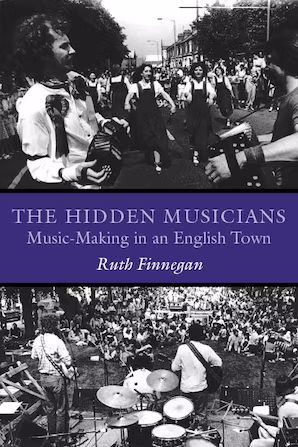A couple months ago I saw Daniel Levitin speak about his new book The World in Six Songs: How the Musical Brain Created Human Nature. A question & answer session followed his talk. The final person given the chance to ask Levitin a question opted instead to make the observation that music a less participatory activity here in the 21st century. Levitin agreed and noted that instead of performing songs with family and friends, most people today are merely listeners who encounter music on the radio, at a venue, or take musical succor from an iPod. To counter this state of affairs, the evening ended with both speaker and audience singing a verse or two of Pete Seeger's "If I Had a Hammer."
This impromptu bit of sing-along served as a nice coda to the book which I had recently finished, Ruth Finnegan's The Hidden Musicians: Music-Making in an English Town. Nearly thirty years ago Finnegan began surveying the musical landscape of Milton Keynes, a suburb of London. Last year her seminal book was republished and it provides a fascinating glimpse into a world of music-making that remains relevant today in the age of the Internet and the MP3.
The musicians that Finnegan refers to in the title of her book are amateurs of all stripes whose activities she studied and documented in the first half of the 1980s. Her focus was on music as a commitment and activity which enriched the performers and audiences alike, as opposed to a vocation which satisfied pecuniary needs. Music as a text was also ignored so music theory and examinations of how pieces came to be were strictly avoided.
After a couple introductory chapters, Finnegan describes a broad scene populated by amateur musicians practicing a panoply of styles. There were classical orchestras, choirs, jazz bands, folkies, rock groups, and even people playing country & western. They performed at pubs, churches, public halls, schools, and at festivals. Music seemed to permeate almost every aspect of urban life in Milton Keynes. Children learned to play at school and via private lessons, there were concerts where music was the main attraction and there were events where music was a secondary attraction or provided a backdrop to other activities.
While being a work of ethnomusicology, The Hidden Musicians is also part oral history as it details why thousands of people in her town dedicated countless hours to the pursuit of music. For example, some outfits, especially choirs and brass bands, had histories going back decades and many performers said that embracing traditions and making them their own held great meaning for them. It was common for people to note how their musical activities were intricately bound with friendships and socializing as well as the inherent joys of creating and playing music.
Meticulously, Finnegan examines each genre and looks at who participates in the associated scenes. She investigates who the musicians are, their motivations, and where they perform. Also noted are the audiences and their various expectations. The great virtue of the book is that it never strays far from the proposition "that music whether in Milton Keynes or elsewhere has many non-musical implications." Music itself may be romantically endowed with abstraction and universality but, for amateur musicians, their avocation requires time, commitment, and a juggling act to balance performance with work and family.
Much of The Hidden Musicians is devoted to what most people already know, namely, that amateur musicians work very hard for little or no pay. However, what makes this a particularly important and engaging work is how Finnegan documents the ways in which music is part of the tapestry of life for urban dwellers who, the prevailing wisdom tell us, are strangers to each other in a sea of humanity. What The Hidden Musicians reveals is that music is much more than a distraction or simply entertainment. It is a fundamental avenue for creating and strengthening social ties and a path for people to express themselves in a myriad of ways.
(This was originally published at The Green Man Review back in 2003-08.)

No comments:
Post a Comment